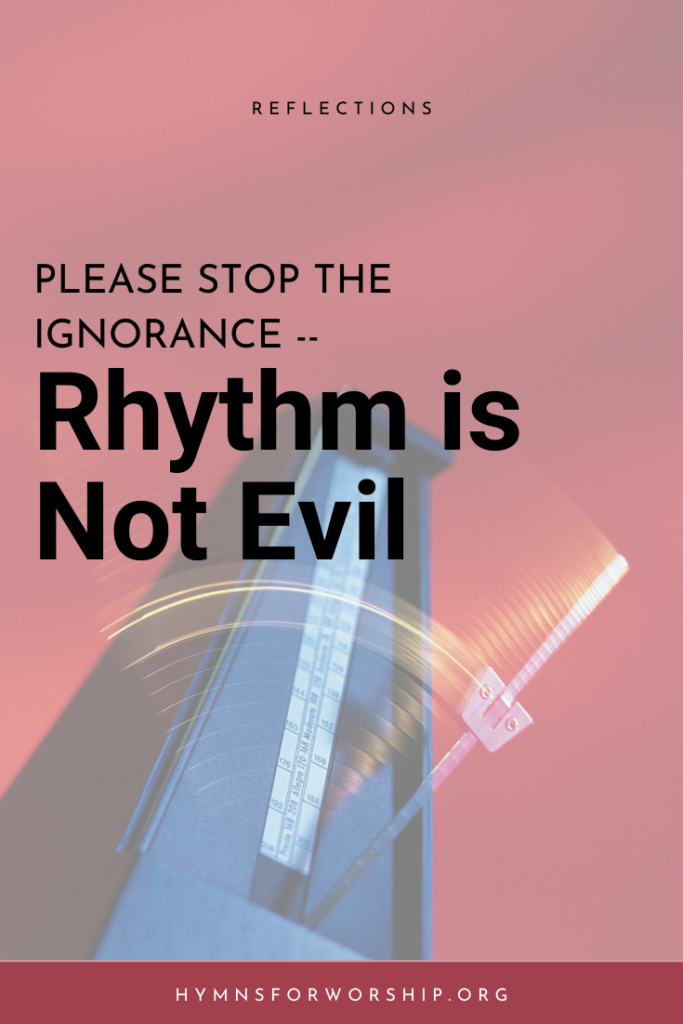
There is a general misconception in many worship and music discussions that rhythm is evil. Sadly, this particular topic has been the source of many heated debates.
I for one have played referee on numerous occasions when such a debate ensues between the ultra conservative “syncopation is of the devil” camp versus the modern musician that says “syncopation is so cool, ima gonna use it alot” camp. And it drives me crazy. Rhythm, particularly syncopation, is NOT evil, you guys!
For starters, rhythm is a vital part of life. The most basic things we do to survive like breathe, work, eat, walk, run all have something to do with rhythm. Our hearts beating is rhythm itself, for crying out loud.
Nature is pregnant with manifestations of rhythm. The cycles of day and night, the seasons, the concepts of light and darkness, the movement of the wind and waves, the lunar cycle of weeks are all part of the rhythmic humdrum that was created by God from the very beginning.
Hence it is not a surprise that rhythm is also a basic ingredient of music.
Rhythm in Music
Rhythm has a very important role in music in that it functions as the main organizer of sounds. Without it, melodies and harmonies float in the air without direction. However, as much as these two elements need rhythm, a rhythmic pattern can stand on its own two feet without melody or even the baseline of the harmony.
Rhythm is also that mysterious element of music that can hypnotize, invoke sensual feelings and heighten emotions. For some, it it that element which is irresistable…making our bodies surrender to it easily.
Let’s look closely at the elements of rhythm and see why it is a crucial and vital ingredient to music. Hopefully, I am able to clear the confusion on the usage of some of these terminologies.
Element No. 1: Pulse
At the heart of rhythm lies the concept of beat or pulse. This is so important to understand because this is one of the main aspects of rhythm that has created many animated debates in church.
The first sensation we had of beat or pulse is that time when we were in our mother’s womb. But the most plausible instance where we were most conscious of rhythm is when we got up on our knees, hands and back sides, and started to walk on our two feet. With practice, our gait became more consistent: left, right, left, right. We began to learn to walk so consistently that after awhile we didn’t even have to think about it.
That consistency, the basic pulse, is what keeps the music moving. The beat is present in all types of music, even in the most conservative, holiest music you can think of. The difference though is that in some types of music, the beat is implied while in other types of music it is thrashed out and shoved on your face.
Most “classical” music, the style in which most hymns are written, use implicit pulse. The beat is there, but hidden away, supporting the movement of melody and harmony. It gives the feeling of serenity and tranquility, like walking leisurely on the beach at sunset.
On the other hand, most popular music, the style in which a lot of contemporary Christian music are written, use explicit pulse. The beat is there, certainly not hidden, because it gives the song excitement and adrenaline, like a hurried pace on the streets of a busy city.
Element No. 2: Tempo
The pulse can be altered by speeding it up or slowing it down. In the elitist world of classical music, the Italian term “tempo” is used to conjure the speed of the pulse. Other terms such as andante, largo, allegro, moderato, etc., all indicate the fastness or slowness of the pulse. In some music, an indication of actual speed is suggested. In fact, you may have seen this in some music pieces.
This simply indicates the bpm, or beats per minute. In this case, there should be 120 quarter notes played within a minute.
The preciseness of the tempo came about especially with the advent of the metronome. However, anyone who has played music with this piece of machinery for an extended amount of time knows that it is hard to keep up with. This is because we, homo sapiens, are not robots.
In fact, the tempos in which we may sing a song or play an instrument may depend on our mood, our energy level, our level of coolness, our sense of urgency, excitement or fear as well as our knowledge of appropriate speeds in music.
Element No. 3: Subdivisions
So we have stripped rhythm to its bare bones, and gave it options for speed. But it is in subdivision that makes rhythm really walk the talk.
To make rhythm work, we have to understand that the pulse, while it can be fast or slow, can also be broken up into smaller pockets of time, or combined to make bigger units of sonic space.
If you have dabbled with music at some point in your life, you might be probably familiar with this basic hierarchy of notes and their subdivisions:
Once the beats are subdivided, determining which beats are important and not is the next step. The important ones gets emphasized, and the other not-so-important beats fit nicely in between. This is where accents come in.
Element No. 4: Accents
When accented, beats are usually called “strong.” Likewise, in the absence of the accent, the beat is called “weak.” This is the nucleus of rhythm and is similar to that of the heartbeat, a “strong-weak” pair of beats. The first beat is accented while the second one is not.
In fact, whether we like it or not, numerous studies have already concluded that our brains are wired to accent the first beat. The brains prefer this in a two-beat, three-beat and four-beat pattern. What is even more astonishing is that the brain automatically superimposes a strong first beat when hearing a consistent beat pattern.
And then the trick of shifting accents was introduced. The weaker beats are articulated, while the strong beats are de-emphasized. This gave music an extra charge of excitement and energy. It also created a side effect, which we call syncopation.
Syncopation was not a new-fangled notion that the rock n’ roll industry introduced to the music scene. It has been a musical device used by composers in Western history, all the way back to the medieval period. Even the hymns are not stranger to the idea of syncopated rhythms.
However, it has been employed more extensively by 20th and 21st century musicians. This was done in many different explicit ways, most familiar to people would be the strum of the guitar and the beat of the drum on the weak beats, or the absence of sound on the strong beats.
It cannot be denied that with syncopated rhythms, music became more loose, playful and mischievous. It was a sneaky shifting of the beat slightly ahead of or slightly behind where you expect it to be.
Syncopation is not evil, but it can be used for evil
It is true that syncopation in the 20th century gave birth to jazz, rock and its hybrid forms. It is also true that there are syncopated rhythms formed as a result of cross-rhythms in vodoo practices. In this instance, people go wild, the body gets groovy, and the mind goes in a state of altered consciousness.
Studies have also shown that extensive listening to syncopated beats induces a release of epinephrine, which stimulates the body to be more aggressive and violent. It atrophies the brain. It stresses the body. It increases heart rate. And many many more side effects.
But please take note, this happens only because syncopation was not used appropriately.
Rhythm has a power to stimulate emotions and excite passion. Use syncopation judiciously, and music becomes inspiring, interesting and meaningful. Use it excessively, and music becomes sensual and intoxicating. It is a powerful tool which can be easily misused and abused.
In worship, we have established the fact that music is used to praise God. The natural way in which God has instigated rhythm in music is not to rub it on our faces, but to enjoy its beauty in a hidden and submissive way.
Like this article? Share it!



